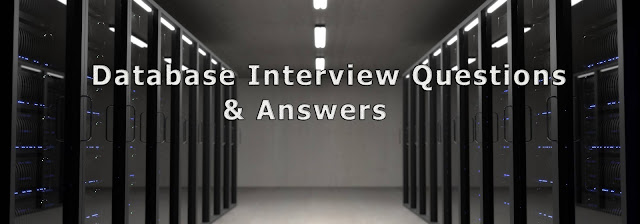 |
| Database Interview Questions & Answers |
Most commonly asked computer science interview questions and answers
1- What is database?
Database is a collection of data related to a particular topic or subject.The information it can store can be any thing such as names,addresses,orders,users etc. A database consists of a collection of object ,that is tables, forms,querys,reports etc.
2- What is DBMS?
A Database Management System (DBMS) is a collection of programs that enables users to create and maintain a database. The DBMS is hence general –purpose software system that facilitates the process of defining ,constructing and manipulating database for various applications.
3- What is Entity?
An entity is a thing of interest to an organization about which date is to be held .Examples of entities include Customer ,Employee , Stock Items etc.
4- What is RDBMS?
Relational Database Management System(RDBMS) is based on a relational model of data that is stored in databases in separate tables and they are related to the use of a common column. Data can be accessed easily from the relational database using Structured Query Language (SQL).
5- What is Attribute?
An attribute is a property or characteristic of an entity.
6- What is record?
All the information about one person or item is held in a record. When a record are store in a table then rows represent records and columns represent fields.
7- What is Data Warehousing?
The storage as well as access to data, that is being derived from the transactions and other sources, from a central location in order to perform the analysis is called Data Warehousing.
8- What are the disadvantages of a Query?
Disadvantages of a Query are:
- Indexes are not present.
- Stored procedures are excessively compiled.
- Difficulty in interfacing.
9- What is Relationship?
A relationship is a link between entities.
10- What is E-R Diagram?
An entity-relationship diagram is a diagrammatic way of representing the relationship between the entities in a database.
11- What are query?
Query is a tool to get information from a database by asking specific questions. Queries are used to select records form tables, rather than presenting all the record in a table.
12-What are Columnar Reports?
In columnar reports the values of each field in each record of a table or query are listed in one long column of text boxes.
13- What are Tabular Reports?
In tabular reports the values of each field in each record of a table or query are listed in rows under the column header.
14- What are the disadvantages of file processing systems?
- Inconsistent
- Not secure
- Data redundancy
- Difficult in accessing data
- Data isolation
- Data integrity
- Concurrent access is not possible
- Limited data sharing
15- What is string?
A sequence of characters used for storing and processing words, name, addresses etc.
16- What do you understand by the Unique key?
A Unique key is the same as the primary key whose every row data is uniquely identified with a difference of null value i.e. Unique key allows one value as a NULL value.
17- How do you communicate with an RDBMS?
You have to use Structured Query Language (SQL) to communicate with the RDBMS. Using queries of SQL, we can give the input to the database and then after processing of the queries database will provide us the required output.
18- What Are Fact Tables?
Tables which track the progress of a certain process or activity, the primary tables of databases.
19- Define Ddl And Dml?
Data Definition Language
Managing properties and attributes of database is called Data Definition Language(DDL).
Data Manipulation Language
Manipulating data in a database such as inserting, updating, deleting is defined as Data Manipulation Language. (DML)
20- Define B-trees?
A data structure in the form of tree which stores sorted data and searches, insertions, sequential access and deletions are allowed in logarithmic time.
21- What is Data Integrity?
Data Integrity is the assurance of accuracy and consistency of data over its entire life-cycle, and is a critical aspect to the design, implementation and usage of any system which stores, processes, or retrieves data. It also defines integrity constraints to enforce business rules on the data when it is entered into an application or a database.
22- What is Normalization?
Normalization is a database design technique that organizes tables in a manner that reduces redundancy and dependency of data.Normalization represents the way of organizing structured data in the database efficiently. It includes creation of tables, establishing relationships between them, and defining rules for those relationships. Inconsistency and redundancy can be kept in check based on these rules, hence, adding flexibility to the database.
23- What are Tables and Fields?
A table is an organized collection of data stored in the form of rows and columns. Columns can be categorized as vertical and rows as horizontal. The columns in a table are called fields while the rows can be referred to as records.
24-What are the advantages of normalization?
- Reduces redundancy and Dependency of data
- Reduction of redundant data.
- Data consistency within the database.
- More flexible database design.
- Better handle on database security.


2 Comments
Nice bro
ReplyDeleteGood one
ReplyDelete